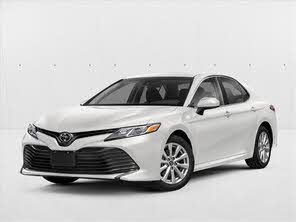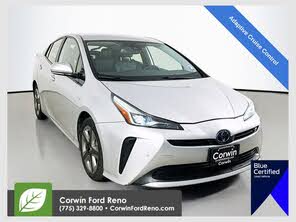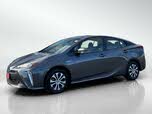2020 Toyota Camry vs 2020 Toyota Prius
Overview | |
MSRP$24,425 | MSRP$24,325 |
Listings1426 | Listings125 |
Ratings & Reviews | |
User Reviews | User Reviews |
Expert reviews7.5 out of 10 | Expert reviews7.5 out of 10 |
Pros
Cons
| Pros
Cons
|
2020 Toyota Camry Reviews SummaryIf you can't beat them, join them. That seems to be Toyota's philosophy in updating the eighth generation of the Camry for the 2020 model year. This latest version of the perennial best seller debuted in 2017 as a 2018 model—and promptly lost its sales crown to Toyota's own RAV4 crossover SUV. As buyers continue to defect from cars, Toyota hopes to entice more shoppers to stick with its midsize sedan by offering all-wheel drive on the Camry for the first time since 1991. Also new for 2020 is the Camry TRD, a sportier version with a 301-horsepower V6 engine that makes its case to a buyer who might never have considered a Camry. | |
2020 Toyota Prius Reviews SummaryEver heard of an eponym? It’s a brand or product that is so popular that it’s come to define its respective market. Think of Kleenex for tissues or Band-Aid for medical bandages. For hybrids, the Toyota Prius has ascended to near-eponym status. It was one of the first—and remains one of the most popular—hybrids ever made. As automakers across the industry are rolling out more hybrid models, the Prius continues to be the standard-bearer of this genre. This is largely due to the fact that the Prius is a dedicated hybrid, rather than a hybrid variant of an existing model. Throughout the industry, different companies are taking different approaches to alt-fuel vehicles, including full-electric and hydrogen fuel cell powertrains. The Prius endures as the leader in hybrid power due to a focus on fuel efficiency that doesn’t compromise on style, drivability, and versatility. So how does the Prius hold its ground as more players enter the fray? Read on to find out. | |
No video found | No video found |
Popular Features & Specs | |
Engine2.5L 203 hp I4 | Engine1.8L 121 hp I4 Hybrid |
Drive TrainFWD | Drive TrainFWD |
Seating Capacity5 | Seating Capacity5 |
EV Battery Capacity | EV Battery Capacity0.7 kWh |
MPG City29 | MPG City58 |
MPG Highway41 | MPG Highway53 |
Engine | |
Engine Name2.5L 203 hp I4 | Engine Name1.8L 121 hp I4 Hybrid |
DrivetrainFWD | DrivetrainFWD |
Fuel Economy | |
EV Battery Capacity | EV Battery Capacity0.7 kWh |
MPG City29 | MPG City58 |
MPG Highway41 | MPG Highway53 |
Interior | |
Seating Capacity5 | Seating Capacity5 |
Safety | |
Front Crash Overall5 | Front Crash Overall4 |
Side Crash Overall5 | Side Crash Overall5 |
Dimensions & Capacity | |
Cargo Space14.1 cu ft | Cargo Space27.4 cu ft |
Curb Weight3241 lbs | Curb Weight3010 lbs |
Height56.9 in | Height57.9 in |
Length192.1 in | Length180.0 in |
Width72.4 in | Width69.3 in |
Wheelbase111.2 in | Wheelbase106.3 in |
Maximum Payload925 lbs | Maximum Payload825 lbs |
Number of doors4 | Number of doors4 |
Overview | ||
MSRP | $24,425 | $24,325 |
Listings | ||
Ratings & Reviews | ||
User reviews | ||
Expert reviews | 7.5 out of 10Read full review | 7.5 out of 10Read full review |
Pros & cons | Pros
Cons
| Pros
Cons
|
Summary | If you can't beat them, join them. That seems to be Toyota's philosophy in updating the eighth generation of the Camry for the 2020 model year. This latest version of the perennial best seller debuted in 2017 as a 2018 model—and promptly lost its sales crown to Toyota's own RAV4 crossover SUV. As buyers continue to defect from cars, Toyota hopes to entice more shoppers to stick with its midsize sedan by offering all-wheel drive on the Camry for the first time since 1991. Also new for 2020 is the Camry TRD, a sportier version with a 301-horsepower V6 engine that makes its case to a buyer who might never have considered a Camry. | Ever heard of an eponym? It’s a brand or product that is so popular that it’s come to define its respective market. Think of Kleenex for tissues or Band-Aid for medical bandages. For hybrids, the Toyota Prius has ascended to near-eponym status. It was one of the first—and remains one of the most popular—hybrids ever made. As automakers across the industry are rolling out more hybrid models, the Prius continues to be the standard-bearer of this genre. This is largely due to the fact that the Prius is a dedicated hybrid, rather than a hybrid variant of an existing model. Throughout the industry, different companies are taking different approaches to alt-fuel vehicles, including full-electric and hydrogen fuel cell powertrains. The Prius endures as the leader in hybrid power due to a focus on fuel efficiency that doesn’t compromise on style, drivability, and versatility. So how does the Prius hold its ground as more players enter the fray? Read on to find out. |
Video | No video found | No video found |
Popular Features & Specs | ||
Engine | 2.5L 203 hp I4 | 1.8L 121 hp I4 Hybrid |
Drive Train | FWD | FWD |
Seating Capacity | 5 | 5 |
EV Battery Capacity | 0.7 kWh | |
MPG City | 29 | 58 |
MPG Highway | 41 | 53 |
Engine | ||
Engine Name | 2.5L 203 hp I4 | 1.8L 121 hp I4 Hybrid |
Drivetrain | FWD | FWD |
Fuel Economy | ||
EV Battery Capacity | 0.7 kWh | |
MPG City | 29 | 58 |
MPG Highway | 41 | 53 |
Interior | ||
Seating Capacity | 5 | 5 |
Safety | ||
Front Crash Overall | 5 | 4 |
Side Crash Overall | 5 | 5 |
Dimensions & Capacity | ||
Cargo Space | 14.1 cu ft | 27.4 cu ft |
Curb Weight | 3241 lbs | 3010 lbs |
Height | 56.9 in | 57.9 in |
Length | 192.1 in | 180.0 in |
Width | 72.4 in | 69.3 in |
Wheelbase | 111.2 in | 106.3 in |
Maximum Payload | 925 lbs | 825 lbs |
Number of doors | 4 | 4 |
The 2020 Toyota Camry had a renewed focus on quality and appeal, aiming to reclaim its reputation for reliability and value. Its styling was more expressive than ever, with bold front fascia and taut lines that gave it a sporty look. The interior featured uniformly nice materials and a driver-focused dashboard, making even the base trims feel upscale. The TRD model added red trim accents, including bright red seatbelts, enhancing its sporty appeal. Despite these improvements, the Camry remained a mainstream sedan with a starting price of $25,380, not quite reaching the luxury or sport sedan status.
The 2020 Toyota Prius maintained its iconic jellybean-like shape, optimized for aerodynamics. The latest generation featured visual tweaks to give it a more sedan-like appearance while retaining its hatchback functionality. The Prius had a futuristic style, with a cabin defined by centrally located instrumentation and gauges. The interior was spacious, with comfortable front seats and good driver visibility. The rear seats also offered ample space, and the hatchback design provided excellent cargo versatility, making it one of the most spacious options among hybrid and electric vehicles.


















The 2020 Toyota Camry offered four distinct powertrains: a 2.5-liter four-cylinder with FWD, the same engine with AWD, a FWD 3.5-liter V6, and a hybrid powertrain. The 3.5-liter V6 produced 301 horsepower and was paired with an eight-speed automatic transmission, providing smooth and powerful performance. The 2.5-liter four-cylinder engine delivered 203 hp (206 in XSE trim) and offered a lighter, more agile driving experience. The AWD system, similar to that in the RAV4, could send up to half of the engine's 184 pound-feet of torque to the rear wheels when needed. The front-drive Camry had an EPA combined fuel economy rating of 31 mpg, dropping to 28 mpg with AWD. The V6 models managed 26 mpg, except for the TRD, which was rated at 25 mpg.
The 2020 Toyota Prius featured a 1.8-liter four-cylinder engine paired with an electric motor, producing a combined 121 horsepower and 105 pound-feet of torque. The Prius AWD-e variant added a second electric motor for the rear wheels, operating at speeds up to 43 mph. The Prius offered smooth acceleration and seamless transitions between electric and conventional power. It had three drive modes: EV, Eco, and Power, each catering to different driving needs. The unique shifter design and Engine Braking mode added to its distinctive driving experience. The Prius handled well, with a low center of gravity providing sharper handling than expected for a vehicle focused on efficiency.
The 2020 Toyota Camry was user-friendly, with most controls easily accessible. The front seats offered increased legroom and hip room compared to the previous generation. However, the rear seat had slightly reduced legroom and overall passenger volume, making it tighter than some competitors. The trunk space was 15.1 cubic feet, smaller than several rivals. The addition of AWD did not compromise the trunk or passenger space, thanks to modifications in the floor structure and fuel tank.
The 2020 Toyota Prius made excellent use of its compact platform, with deep door pockets and a large tray area between the front seats for storage. The front seats were spacious and comfortable, with good headroom and legroom. The rear seats also provided ample space, though taller passengers needed to be cautious when entering and exiting. The Prius offered 50.7 cubic feet of cargo space with the rear seats folded and 24.6 to 27.4 cubic feet with the seats up, depending on the trim. The hatchback design made loading and unloading easy, enhancing its practicality.
The 2020 Toyota Camry came standard with a 7-inch touchscreen, now including Android Auto, Apple CarPlay, Amazon Alexa compatibility, and a three-month trial of SiriusXM satellite radio. The infotainment system, while functional, felt dated with low-resolution graphics. Higher trims offered an 8-inch screen and a 10-inch head-up display. A three-month trial of WiFi Connect and a one-year trial of Remote Connect were also available, enhancing connectivity and convenience.
The 2020 Toyota Prius featured a standard 7-inch touchscreen with a sensible menu layout, Android Auto, Apple CarPlay, Bluetooth connectivity, a WiFi hotspot, and three USB ports. The Limited trim upgraded to an 11.6-inch screen with a customizable, tablet-like layout. This larger screen lacked Android Auto but included satellite radio, HD Radio, and a 10-speaker JBL premium audio system. The top-center instrument panel provided hybrid drivetrain status and other critical readouts, with an available HUD for added convenience.
The 2020 Toyota Camry included Toyota Safety Sense, featuring a pre-collision system with emergency braking, dynamic radar adaptive cruise control, lane-departure warning with steering assist, and automatic high beams. Optional features included blind-spot monitoring and rear cross-traffic alert. The Camry earned a five-star rating from the NHTSA and a Top Safety Pick+ from the IIHS. There was one NHTSA recall for leaking engine coolant, affecting up to 44,191 cars with 2.5-liter engines.
The 2020 Toyota Prius came with Toyota Safety Sense 2.0, including automatic emergency braking, forward-collision warning, lane-departure warning, adaptive cruise control, and automatic high beams. Optional features included blind-spot monitoring, rear cross-traffic alert, parking sensors, and active park assist. The Prius earned a five-star rating from the NHTSA and a Top Safety Pick from the IIHS, though it fell short of the Top Safety Pick+ rating due to "average" scores in certain crash tests and headlight performance.
CarGurus highlights

According to CarGurus experts, the overall rating for the 2020 Toyota Camry is 7.5 out of 10, while the 2020 Toyota Prius scores 7.5 out of 10. Both vehicles offer unique strengths, but the final recommendation depends on your priorities. If you seek a sportier design and more powerful engine options, the Camry is the better choice. However, if fuel efficiency, cargo space, and advanced safety features are your main concerns, the Prius is the way to go.
Choose the 2020 Toyota Camry if:
- You prefer a sedan with a sportier design and more powerful engine options.
- You value a user-friendly interior with good front-seat space and intuitive controls.
- You want a car with a high safety rating and comprehensive safety features.
Choose the 2020 Toyota Prius if:
- You need a hybrid vehicle with excellent fuel efficiency and smooth acceleration.
- You prioritize cargo space and versatility, especially with the hatchback design.
- You appreciate advanced safety features and a high safety rating.
CarGurus highlights

According to CarGurus experts, the overall rating for the 2020 Toyota Camry is 7.5 out of 10, while the 2020 Toyota Prius scores 7.5 out of 10. Both vehicles offer unique strengths, but the final recommendation depends on your priorities. If you seek a sportier design and more powerful engine options, the Camry is the better choice. However, if fuel efficiency, cargo space, and advanced safety features are your main concerns, the Prius is the way to go.
Choose the 2020 Toyota Camry if:
Shop Now- You prefer a sedan with a sportier design and more powerful engine options.
- You value a user-friendly interior with good front-seat space and intuitive controls.
- You want a car with a high safety rating and comprehensive safety features.
Choose the 2020 Toyota Prius if:
Shop Now- You need a hybrid vehicle with excellent fuel efficiency and smooth acceleration.
- You prioritize cargo space and versatility, especially with the hatchback design.
- You appreciate advanced safety features and a high safety rating.

By: CarGurus + AI
At CarGurus, our team of experienced automotive writers remain at the heart of our content operation, conducting hands-on car tests and writing insightful guides that are backed by years of industry experience. To complement this, we are harnessing AI to make our content offering more diverse and more helpful to shoppers than ever. To achieve this, our AI systems are based exclusively on CarGurus content, ratings and data, so that what we produce is both unique to CarGurus, and uniquely helpful to car shoppers.






































